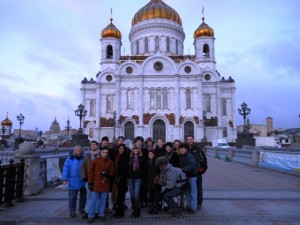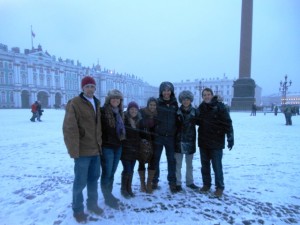 “Taking this trip to Russia was enlightening and it was awesome to be engulfed in another culture,” says Casey Schmalacker ’12 (Great Neck, N.Y.), a double major in economics and government & law. “It was so great having professors who could help you acclimate to the different culture, while also allowing you to go out exploring on your own.”
“Taking this trip to Russia was enlightening and it was awesome to be engulfed in another culture,” says Casey Schmalacker ’12 (Great Neck, N.Y.), a double major in economics and government & law. “It was so great having professors who could help you acclimate to the different culture, while also allowing you to go out exploring on your own.”
Over winter break, Schmalacker was one of 14 students with majors from all four of the College’s divisions who traveled to Russia for the course The New Russia and the Old. The three-week class was taught by Rado Pribic, Oliver E. Williams Professor of Languages & Literatures and chair of International Affairs, and Valeria Sajez, lecturer of Russian.
Through firsthand experience of Russia–-with examination of official statements, the views of citizens, and critical points of view–-students studied social changes, how they came about, the problems the new Soviet society faced, the meaning of World War II for the Russians, the rationale for Soviet domestic and foreign policies, and today’s complex situation.
Pribic has been directing the Russia interim course for the last 30 years. “It is imperative for American students to know about the largest country in the world which, next to the U.S., is the only country that can totally destroy our world with its nuclear arsenal. Nowadays, Russia is very important because of its oil and gas reserves.”
For Alyssa Hollander ’14 (Holmdel, N.J.), an anthropology & sociology major, choosing to go on this interim trip was an easy decision. “The majority of my family has Russian heritage, so I wanted to visit and learn more about the history and culture of the country of my ancestors.”
 Hollander’s favorite moments included a visit to Leo Tolstoy’s estate in Yasnaya Polyana, right outside of Moscow. “Being able to step into the shoes of such a prominent and important literary figure was exciting,” she says.
Hollander’s favorite moments included a visit to Leo Tolstoy’s estate in Yasnaya Polyana, right outside of Moscow. “Being able to step into the shoes of such a prominent and important literary figure was exciting,” she says.
“I was completely naive to his ideas and influence on Russia, and this excursion helped me more completely understand the Russian experience,” Schmalacker says.
Another highlight for Hollander was celebrating New Year’s in Red Square. “Being in front of the stunning St. Basil’s Cathedral while the clock counted down and fireworks exploded was special,” she says.
The hallmark of Lafayette’s interim abroad program is the ability to work so closely with faculty, and the students enjoyed learning from Pribic and Sajez.
“They were amazing leaders and were like walking encyclopedias,” says Hollander. “Both had extensive knowledge on any topic and had personal stories that were truly fascinating. You could listen to them for hours.”
Pribic believes it is important for American students to gain a better understanding of Russia.
“Many of them may be in a position of responsibility and may have to make smart decisions in dealing with Russia,” he says. “More importantly, there are also a good number of employment opportunities for students knowledgeable of Russia and its people.”
Hollander hopes to work in fashion industry after she graduates. “This trip exposed me to many visions of architecture, art, and culture that were new and interesting -– lots of color and combinations that were distinctly Russian. I know this will provide me an expanded set of experiences from which to draw.”
For Schmalacker, this course allowed him to apply knowledge he has gained through studying economics and government. “This trip acted as a case example for my majors. Through this course, I was able to analyze how the government and economy of Russia have developed over time. The course was a good application for everything I have learned over my four years at Lafayette.”
 “Taking this trip to Russia was enlightening and it was awesome to be engulfed in another culture,” says Casey Schmalacker ’12 (Great Neck, N.Y.), a double major in economics and government & law. “It was so great having professors who could help you acclimate to the different culture, while also allowing you to go out exploring on your own.”
“Taking this trip to Russia was enlightening and it was awesome to be engulfed in another culture,” says Casey Schmalacker ’12 (Great Neck, N.Y.), a double major in economics and government & law. “It was so great having professors who could help you acclimate to the different culture, while also allowing you to go out exploring on your own.” Hollander’s favorite moments included a visit to Leo Tolstoy’s estate in Yasnaya Polyana, right outside of Moscow. “Being able to step into the shoes of such a prominent and important literary figure was exciting,” she says.
Hollander’s favorite moments included a visit to Leo Tolstoy’s estate in Yasnaya Polyana, right outside of Moscow. “Being able to step into the shoes of such a prominent and important literary figure was exciting,” she says.